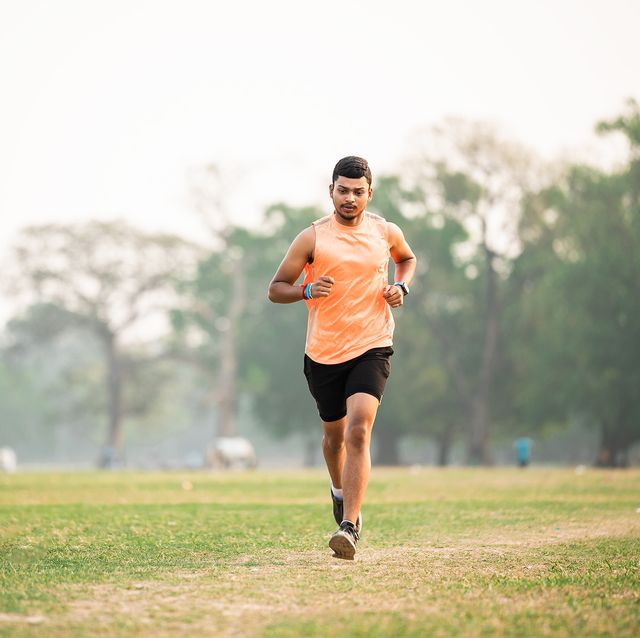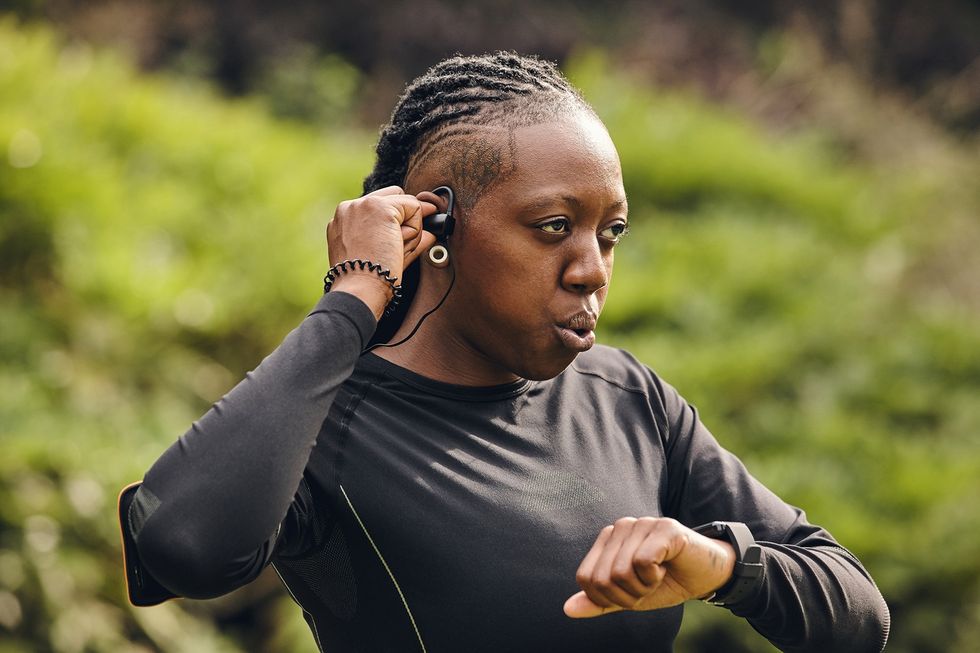We delve into the latest research and science on how exercise – including running – can help to alleviate symptoms of anxiety.

Getty Images
Over eight million people in the UK are living with an anxiety disorder at any one time – that’s a little over 1 in 10. In Australia, 17.2% of all mental health disorders in people aged 16-85 years was anxiety in 2020-2022.
While causes of anxiety are complex, things like financial worries, social isolation, stress at work, bereavement, racism or abuse can all trigger anxiety – and a new study by the Mental Health Foundation has revealed that the UK population is experiencing widespread levels of anxiety and stress in response to the current cost-of-living crisis.
While it is normal to feel anxious from time to time, anxiety disorders are characterised by feeling anxious all of – or most of – the time and can have a debilitating affecting on a person’s daily functioning and wellbeing. They can also co-occur with other mental health disorders, such as depression.
Generalised anxiety disorder (GAD) is the most common type of anxiety disorder and presents as excessive worrying about different activities and events. However, there are many different types of disorders which all present differently and can all vary in severity. These include: Panic Disorder (PD), Posttraumatic Stress Disorder (PTSD), Obsessive Compulsive Disorder (OCD), Social Anxiety Disorder and Specific Phobia.
It’s well-documented that exercise – including running – can benefit our mental health, and even compares favourably to antidepressant medications as a first-line treatment for mild to moderate depression. And while not as extensively studied, exercise has also been shown to be an effective and cost-efficient treatment alternative for a variety of anxiety disorders.
For example, a 2018 systematic review and meta-analysis, published in BMC Health Services Research, compared the use of exercise intervention to a waiting list control group in the treatment for anxiety. Exercise included running, walking, treadmill training or supervised aerobic training sessions, carried out regularly for at least two weeks. It found that aerobic exercise was effective in the treatment of raised anxiety compared to the waiting list control groups and that high-intensity exercise (performed to a minimum of 60% HR max or 70% VO2 max) showed greater effects than low-intensity programs.
Moreover, a 2023 study, published in the British Journal of Sports Medicine, examined more than 97 review papers and over 1,000 research trials looking at the effects of physical activity on depression, anxiety and psychological distress. It revealed that exercise – 150 minutes each week of various types of physical activity – is highly beneficial for improving symptoms of anxiety, depression and distress across a wide range of adult populations, including those diagnosed with mental health disorders. Authors concluded that ‘physical activity should be a mainstay approach in the management of depression, anxiety and psychological distress’.
Despite the clear evidence of its benefits, exercise is yet to be widely adopted therapeutically – perhaps because it is so difficult to compare the different studies, and also because of the difficulty of prescribing and monitoring physical activity in a clinical setting.
Instead, treatment options for anxiety and depression in the UK including talking therapy and medication. ‘For depression and any anxiety disorder, they used to prescribe medication as the first port of call but now GPs are trying to refer talking therapies, which includes Cognitive Behavioural Therapy (CBT), as the first-line treatment,’ explains Grimbsy-based NHS CBT therapist Jess Amy Lee, who also works with private patients at JAL Cognitive Behavioural Therapy Service. ‘However, a balance of both can be most effective in some cases.’
CBT helps patients notice and change problematic thinking styles or behaviour patterns, and Lee explains that, as part of CBT, patients are often encouraged to participate in physical activity alongside therapy. ‘Within in CBT, we do a lot of stuff around self-care – and the key pillars of looking after ourselves. If a patient is doing some form of exercise, sleeping well and eating a good diet, they’re going be more likely to recover and do well within therapy, as these can all help to alleviate symptoms of anxiety and help in improving a person’s mood.’
Anecdotally, runners certainly widely attest to the benefits of running in improving anxiety symptoms. Take RW reader Kate Jervis. ‘Running helps my anxiety enormously,’ she says. ‘I find that I can process anxious thoughts, when I’m running, in a rational way. I don’t notice the physical feelings of anxiety, like my heart racing, because it is already racing from exercise. When I have finished my run, my head feels clear and my body relaxed.’
In the 2020 book Physical Exercise for Human Health, chapter authors Dr Aaron Kandola and Dr Brendon Stubbs explain that the way in which exercise reduces symptoms of anxiety is ‘likely to involve a combination of biological and psychological factors. But what exactly is going on inside our bodies and our brains when we run, which can help us to feel less anxious?
How does exercise help reduce anxiety – biologically and psychologically?

Getty Images
The benefits of exercise on mental health consist of a range of complex neurobiological factors.
There are multiple mechanisms that explain the brain-enhancing effects of exercise in combating anxiety, which have been demonstrated in research on animal studies and in a growing number of clinical studies on humans. ‘Exercise has a powerful multisystem effect on the mind and body,’ explains clinical lecturer and ASICS ambassador Dr Stubbs, an acclaimed academic researcher in the field of physical activity and mental health and the mind-body interface. ‘No longer can we simplify the benefits of exercise on mental health to one molecule or pathway, including the benefits on anxiety. The benefits we have found consist of a range of complex neurobiological factors such as brain-derived neurotrophic factor (BDNF), serotonin, dopamine, reducing inflammatory cytokines and cortisol and changing structural pathways in the brain, eg. the hippocampus and prefrontal cortex.’
So, what does all of this mean? Let’s look at some of these neurobiological factors individually, starting first with brain-derived neurotrophic factor (BDNF), which has been shown to increase when we exercise. ‘It can be thought of as a brain fertiliser,’ explains Stubbs, who co-authored the first evidence-based book on the use of physical activity for the treatment of people with mental illness. ‘It helps to stimulate activity in the brain in the short and long term – notably increasing the connections (synapses) between key areas of the brain and helps stimulate the growth of new nerve cells.’
‘BDNF is reduced in people with anxiety,’ Stubbs continues, ‘and the release of this helps to stimulate the activation of brain areas that are reduced in size or functioning less well such as the hippocampus, prefrontal cortex and anterior cingulate cortex.’
So what about the neurotransmitters serotonin and dopamine, which are also raised when we exercise? ‘Serotonin is thought to influence mood and dopamine is a reward neurotransmitter and provides a feeling of achievement. The effects of each of these is more powerful when combined with one another,’ explains Stubbs.
No longer can we simplify the benefits of exercise on mental health to one molecule or pathway
While endorphins – the ‘happy hormone’ – have long thought to explain the feel-good factor many of us experience after a run, Stubbs says the importance of endorphins has been greatly overstated. ‘This is far too simplistic and doing exercise and the human body/mind a great disservice, as the mechanisms are multisystem. Moreover, while endorphins are released during exercise, these have difficulty crossing the blood-brain barrier alone unless they are combined with other molecules.’
However, one molecule which can cross the blood-brain barrier is the endocannabinoid. These are neurotransmitters that bind to the cannabinoid receptors in the brain, causing similar effects to those of the active component cannabis – hence the name – including relaxation, reduced stress and pain relief. ‘The relaxed feeling after exercise can be partially accounted for by the release of these endocannabinoids which exert a feeling of calmness,’ explains Stubbs, ‘and that’s particularly important for people with anxiety.’ He says that the endocannabinoid system is central to why we may feel happier after a run.
So where does cortisol come into it – and how is this stress hormone linked to both anxiety but also exercise? Well, it helps to first understand how our body’s stress response works. Our central physiological stress response systems are the hypothalamic-pituitary-adrenal (HPA) axis and the autonomic nervous system (comprising the sympathetic nervous system and parasympathetic nervous system).
When exposed to acute stress, the HPA axis is activated resulting in increased levels of the stress hormones adrenocortic hormone (ACTH) and cortisol. ACTH’s key function is to stimulate the production and release of cortisol, which among other things, increases sugars in the bloodstream, increases blood pressure and increases heart rate. This is your body preparing to ‘fight or flight’.
In people with anxiety disorders, the sympathetic nervous system is on heightened alert. ‘That alarm system is always ticking,’ explains Lee. ‘Things like going to the supermarket become anxiety-provoking but it’s not actually a real threat.’ This results in people feeling constantly on edge when there is no obvious danger to them.
However, research has found that that regular aerobic exercise is associated with lower hypothalamic-pituitary-adrenal (HPA) axis and sympathetic nervous system reactivity. And it seems that more intense exercise may bring a stronger effect. One study found that the cortisol released from exercising intensely – running at 70% of maximum heart rate for 30 minutes – actually suppressed the subsequent cortisol response to a social stress test 45 minutes later. The authors concluded that ‘consistent exercising at vigorous intensities may help to normalise daily cortisol rhythms … among groups particularly vulnerable to stressor exposure’.
How else can exercise help reduce anxiety?

Getty Images
Running with others can encourage social interaction and improve wellbeing.
However, as Stubbs point out, exercise has a powerful multisystem effect on the mind and body – and so although these physiological and biological mechanisms can help explain its anxiolytic effects, so can the various psychological and social factors which are also at play.
Lee and Stubbs both agree that exercise can increase self-esteem and bring a sense of achievement, which can all contribute to alleviating symptoms of anxiety. ‘We find that exercise does increase confidence and self-esteem, which can make patients feel better,’ says Lee. And she also says the social/environmental interactions associated with exercise cannot be dismissed: ‘Patients with anxiety disorders and depression often withdraw from social situations, so exercising with others is a good way of socialising with others encouraging that social interaction which can improve wellbeing’.
Running is certainly often described anecdotally as a mediative experience. RW reader Zoe Barker, who suffers with maternal anxiety, says running – and running with friends – has helped alleviate some of her symptoms. ‘I began to run long distances with my dogs, with my daughter in her buggy, as well as with friends. The head space, gossip and physical exertion helped to control the anxiety and work through the bizarre intrusive thoughts that triggered panic attacks’ she explains.
We find that exercise does increase confidence and self-esteem, which can make patients feel better
Then there are runners who describe running as a great distractor from anxious thoughts and feelings – and there’s research which backs up this idea. ‘I think anxiety happens a lot for me when I’m not engaged in an activity,’ says RW reader Adrienn Prezenszki. ‘Running helps me to take the focus away from my anxious thoughts because I have to think about the route that I’m taking when running outdoors or focusing on my breathing. I also like to listen to music while running so that helps me to take the focus off of my anxious thoughts.’
For this reason, Lee applauds the benefits of running as a distraction tool – especially with music. ‘It can take your mind off things so you can get away from the cycle of thoughts that you might be stuck in. Most people listen to music when they exercise too, and I think the combination of those things is a good way to disrupt that cycle of overthinking.’
She also points to the benefits of doing short bursts of exercise (eg running on the spot) in helping some patients with anxiety disorders – in particular those with panic disorders – to reduce anxiety sensitivity by way of exposure to the physiological symptoms of anxiety. ‘A lot of people that have panic disorders usually have this fear of having a panic attack, which brings about physiological symptoms like rapid heartbeat, breathlessness and dizziness. Someone that has had a panic attack before often fears having another one because they can’t cope with the symptoms that they’re experiencing. So we ask them to expose themselves to those panic symptom – we get people to breathe through a straw so they can replicate hyperventilating or jog on the spot to get their heart rate up.’
This idea is supported by a number of research studies which have pointed to the effectiveness of short-term aerobic exercise in increasing tolerance for the physiological symptoms of anxiety and panic, in showing patients that the feared physiological sensations may be uncomfortable, but do not pose a serious threat.
The benefits of exercise in reducing anxiety are clearly indisputable – but Lee warns against turning to running as standalone solution for alleviating symptoms of anxiety. ‘Although exercise can reduce your chances of anxiety and alleviate symptoms, it might not be enough as a standalone treatment,’ says Lee. ‘If your anxiety is impacting on your day-to-day life or relationships or ability to function, seek help from a mental health professional,’ she advises. ‘Every area of the country has mental health services with the NHS.’
If you are struggling with anxiety, visit your GP who can talk to you about your mental health and help introduce you to the right mental health service. You can also speak to a counselor on an online chat at Anxiety – Beyond Blue

